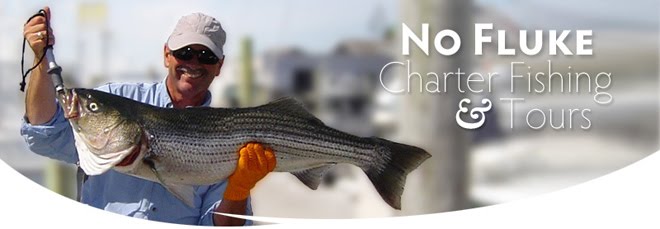Capt. Mike Littlefield of Archangel Charters, Portsmouth, with a 15 pound tautog he caught off Jamestown, RI using a tautog jig and green crabs. The tautog bite was on in 2018.
This 24.5 inch black sea bass was caught off Newport using a pink buck tail on a three-way swivel. The black sea bass are expected to be plentiful (and large) in 2019 in Buzzards Bay and off RI.
Ed Doherty of Mattapoisett (East End Eddie) with a 27 pound striped bass he caught on the Cape Cod Canal. Fishing was good in July of 2018 with Doherty catching a 25, 27 and 31 pound fish on consecutive days.
Lucy Churchill and fiancé Chris
Monti of Providence with the 24” summer flounder she caught at Austin Hollow,
Jamestown in August. Fluke fishing was
difficult in 2018 but some large fish were caught in lower Narragansett Bay.
Fishing will be mixed bag in 2019
The 2018 season
If you worked hard, you caught fish
in 2018. Maybe not what you wanted to
catch, but there were fish to catch.
The school striped bass fishing was
awesome with a number of large fish taken at the Cape Cod Canal, at the
Southwest Ledge Block Island, and with shore anglers catching keepers in the
30” range mixed in with all those smaller bass.
However, the bass bite compared to recent years was way off the mark for
most shore, Bay and ocean anglers.
The tautog season was great with
anglers catching their limit and a number of larger fish, many over 15 pounds,
being caught throughout the fall season.
And, once again this year we filled out our fishing with large scup, a
great black sea bass bite (particularly in spring at Buzzards Bay, off Newport
and Block Island) and sea robins (which more and more anglers are keeping, cleaning
and eating).
Other species such as summer
flounder (fluke) fishing, large striped bass fishing in general, the false albacore
run in the fall were not as robust as we would have liked to see. Offshore we fell short on the bluefin and
yellowfin tuna bite but had an abundance of sharks offshore.
What’s in store for 2019?
Striped bass. Even though a new striped bass stock assessment is
done data from it will not be used for management decisions until 2020. So for 2019 striped bass regulations are
expected to be the same as this year… one fish 28” or larger/person/day. The
striped bass fishing for keeper sized bass will hopefully improve in 2019 with
some of the small school size fish we have been catching in abundance maturing
to keeper sized fish.
However, the stock assessment, is
not good. With the biological reference
points we now have, specifically the Spawning Stock Biomass (SSB), the amount
of spawning fish needed in the water to insure sustainable stock levels, is
showing that striped bass are overfished and overfishing is occurring.
However some fish mangers and
policy makers, being pressured to keep people fishing for striped bass, are
thinking about lowering the amount of spawning stock biomass needed in the
water to insure a sustainable fishing.
This is troubling and equated by many to lowering the basketball rim to
eight feet because at ten feet it is too hard to get a basket.
Data presented to anglers at a
December 19, 2018 Rhode Island DEM public workshop on striped bass clearly
shows show fewer and fewer keeper striped bass have been caught in Rhode Island
and Massachusetts over the past four years.
Lowering our SSB goal to take more fish is being frowned upon by most
conservation minded anglers.
Additionally, the Marine Recreational
Information Program (MRIP), the way fish mangers measure recreational fishing
harvest, has recalibrated its data due to enhanced data collection
strategies. The new recalibrated data
shows that over the years, anglers have been catching more fish than originally
thought. In the case of striped bass,
the data is showing anglers have been catching more than twice the amount of
striped bass than originally thought.
So next year we will be status quo
on striped bass, and the prediction is that the striped bass fishing for
smaller fish will be good, but the bite for the 30, 40 and 50 pound fish will
continue to decline in 2019. How fish
mangers decide to use new stock assessment data will be determined at the
February, 2019 Atlantic States Marine Fisheries Commission meeting. We may have
an indication of the 2020 season after that meeting.
The black sea bass bite will be enhanced in 2019. But the summer flounder bite will likely
remain spotty. The black sea bass bite
is expected to get better with large fish being caught in 2019. Some monster
fish were caught in 2018 (like the 24.5 inch fish caught off Newport on my boat
last year… the State of Rhode Island and U.S. record is 26 inches.)
Summer flounder (fluke) is experiencing overfishing and with a
reduced bite this year, the bite is expected to be the same in 2019… spotty.
Tautog fishing in Massachusetts and Rhode Island will likely be
status quo next year which is a minimum size of 16”. In Rhode Island there is a split season with
three fish allowed in early spring, no fishing during the spawning months of
June and July. The season opens again in
August with three fish and then jumps to five fish/person/day in mid-October. A ten fish boat maximum is still in place for
all seasons.
Where’s the bite?
Cod
and haddock fishing were strong again this week when boats were able to get
out. Party
boats from Rhode Island sailing for cod this time of year include the Frances
Fleet at www.francesfleet.com , the Seven B’s
at www.sevenbs.com, and the Island
Current at www.islandcurrent.com .






